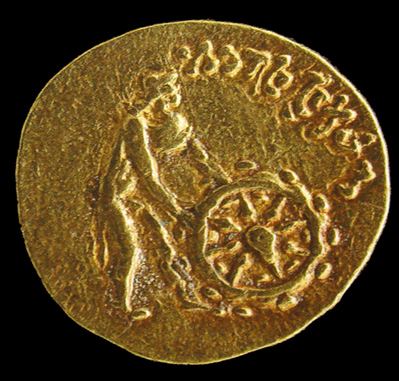Material Gold | Size Height:Width: | |
 | ||
Writing Obverse: Kharoshthi legend Dharmacakrapravata[ko] "The one who turned the Wheel of the Law".Reverse: Kharoshthi legend Sih[o] vigatabhay[o] "The lion who dispelled fear". Period/culture 1st century BCE - 1st century CE Present location Kabul Museum, Afghanistan | ||
The Tillya Tepe Buddhist coin is a gold coin that was discovered at the archaeological site of Tillya Tepe in modern Afghanistan.
Contents
The gold coin from India was found in tomb IV (the male warrior). The archaeological site, as the coin, are dated to the beginning of the Common Era, that is late 1st century BCE to early 1st century CE.
Lion and triratna
On the reverse, it depicts a lion with the Buddhist symbol of the triratna, with the Kharoshthi legend Sih[o] vigatabhay[o] "The lion who dispelled fear".
Hermes iconography
On the obverse can be seen a man who is almost naked, except for an Hellenistic chlamys and a petasus hat (an iconography similar to that of Hermes/ Mercury). He is rolling a wheel along. The legend in Kharoshthi reads Dharmacakrapravata[ko] "The one who turned the Wheel of the Law".
Hermes was considered in ancient Greece as a psychopomp, an intercessor between mortals and the divine, and conductor of souls into the afterlife. Besides similarities in metaphysical roles, the similarity between the names of they respective mothers, Maya for the Buddha and Maia for Hermes, have often been noted, as well as the stories of their miraculous births.
Various identities have been suggested for the being depicted on the coins, from Shiva to Zeus, and most often, the Buddha himself in an early representation.
Chronology
Since the time of the Buddha, Buddhist representations had been aniconic. This raises the possibility that this coin is one of the earliest, if not the earliest, representation of the Buddha.
Earlier connections between Greek deities and Buddhist symbolism appears on the coins of Indo-Greek kings such as Menander II (90–85 BCE), in which Zeus, through Nike, can be seen handing a wreath of victory to a Wheel of the Law.
The next earliest known representation of the Buddha is that of the Bimaran casket, dated circa 50 CE.
